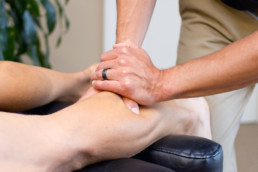Movement Prescription
Active care is essential to sustainable progress. Our comprehensive program is designed to correct dysfunctional movement patterns, restore range of motion, and strengthen the affected structures in a safe and effective manner. Movement based dysfunctions require movement based solutions. We offer individualized movement prescription, delivered on our mobile app platform to guide your recovery.

Hyperbaric Oxygen Therapy may help the body...
Improve Mobility
Develop Motor Control
Build Strength & Resiliency
What is Deep Tissue Laser Therapy?
Laser therapy is a medical treatment that uses focused light to stimulate a process called photobiomodulation (PBM). During PBM, photons enter the tissue and trigger a biological cascade of events that leads to an increase in cellular metabolism, which can decrease pain and inflammation and accelerate the healing process. Laser therapy is used to treat acute and chronic conditions as well as post-activity recovery. When treating acute conditions with laser therapy, it is particularly effective when it is administered as soon as possible following injury. With chronic conditions, laser therapy is used most often to help combat persistent pain and inflammation. To aid in post-activity recovery, LightForce Lasers are used by over 250 pro, college, and Olympic sports teams across the United States and many parts of Europe and East Asia.

Individualized Exercise Programming delivered on our mobile app!
Physiologic Benefits
Accelerated Tissue Repair And Cell Growth
Accelerate cellular reproduction and growth. Unlike other treatment modalities, powerful Class 4 Laser Therapy can penetrate superficial tissues and deliver healing energy to deeper structures and articular surfaces. Cells of cartilage, bone, tendons, ligaments and muscles are repaired faster as a result of exposure to high powered NIR or Near InfraRed Laser photons.
Reduced Fibrous Tissue Formation
Class 4 Laser therapy reduces the formation of scar tissue following tissue damage and acute and chronic inflammatory processes. This point is paramount because fibrous (scar) tissue is less elastic, has poorer circulation, is more pain sensitive, weaker, and much more prone to re-injury and frequent exacerbation.
Anti-Inflammation
Laser light therapy has an anti-inflammatory effect, as it causes vasodilation and activation of the lymphatic drainage system. As a result, there is a reduction in swelling caused by biomechanical stress, trauma, overuse, or systemic conditions. Being able to easy support the movement of lymph support faster healing.
Analgesia
Laser therapy has a multifaceted beneficial effect on pain relief. It activates production of high levels of pain killing chemicals such as endorphins and enkephalins from the brain and adrenal gland. Additionally it initiates the suppression of nerve signal transmission over unmyelinated c-fibers that transmit pain to the brain. This means that a greater amount of stimuli is required to create an action potential within the nerve to signal pain.
Improved Vascular Activity
Laser light will significantly increase the formation of new capillaries (angiogenesis) in damaged tissue that will speed up the healing process. Additionally, it has been noted in the literature that microcirculation increases secondary to vasodilation during laser treatment.
Stimulates Trigger Points and Acupuncture Points
Stimulates muscle trigger points to help release contracted tissues, helps restoration of muscular tonus and balance. Can also be used to quickly and easily treat acupoints and trace meridians to quickly open up blocked energy flow within numerous body systems from the macro to the micro-systems.
What Conditions Will Benefit?
Deep Tissue Laser Therapy has been clinically proven as an effective treatment for a vast array of both acute and chronic conditions.
- Arthritis
- Sports Injuries
- Neck Pain (Cervical Sprain / Strain)
- Back Pain (Lumbar Sprain / Strain)
- Knee Pain (Patellofemoral Disorders)
- Ankle Pain (Achilles Tendinitis)
- Foot Pain (Plantar Fasciitis)
- Shoulder Pain (Rotator Cuff Tendinitis)
- Tennis Elbow (Lateral Epicondylitis)
- Golfer’s Elbow (Medial Epicondylitis)
- Wrist Pain (Carpal Tunnel Syndrome)
- IT Band (Iliotibial Band)
- Repetitive Stress Injuries
- TMJ
- Muscle Strains
- Ligament Sprains
- Shin Splints
- Rheumatoid Arthritis
- Herpes Zoster (Shingles)
- Diabetic Neuropathy
- Diabetic Foot Ulcers
- Trigeminal Neuralgia
- Burns
- Deep Edema / Congestion

Learn More About Deep Tissue Laser Therapy
What to Expect During Treatment
Laser therapy treatments must be administered directly to skin, as laser light cannot penetrate through layers of clothing. You will feel a soothing warmth as the therapy is administered. Many patients receiving LightForce® Therapy Laser treatments report enjoying the experience, especially when a massage-ball treatment head is used to deliver what is often referred to as a “laser massage.”
Patients receiving treatments with higher-power lasers also frequently report a rapid decrease in pain. For someone suffering from chronic pain, this effect can be particularly pronounced. Laser therapy for pain can be a viable treatment.
With LightForce® lasers, treatments are quick usually 3-10 minutes depending on the size, depth, and acuteness of the condition being treated. High-power lasers are able to deliver a lot of energy in a small amount of time, allowing therapeutic dosages to be achieved quickly. For patients and clinicians with packed schedules, fast and effective treatments are a must.
How Many Treatments Are Recommended?
How many treatments a person needs depends on the severity of the health condition. While many people may benefit from a single session, often times more complex conditions may require more frequent treatment. Most clinicians will encourage their patients to receive 2-3 treatments per week as the therapy is initiated. There is a well-documented support that the benefits of laser therapy are cumulative, suggesting that plans for incorporating laser as part of a patient’s plan of care should involve early, frequent treatments that may be administered less frequently as the symptoms resolve. Your doctor will develop a treatment plan that is optimal for your condition.